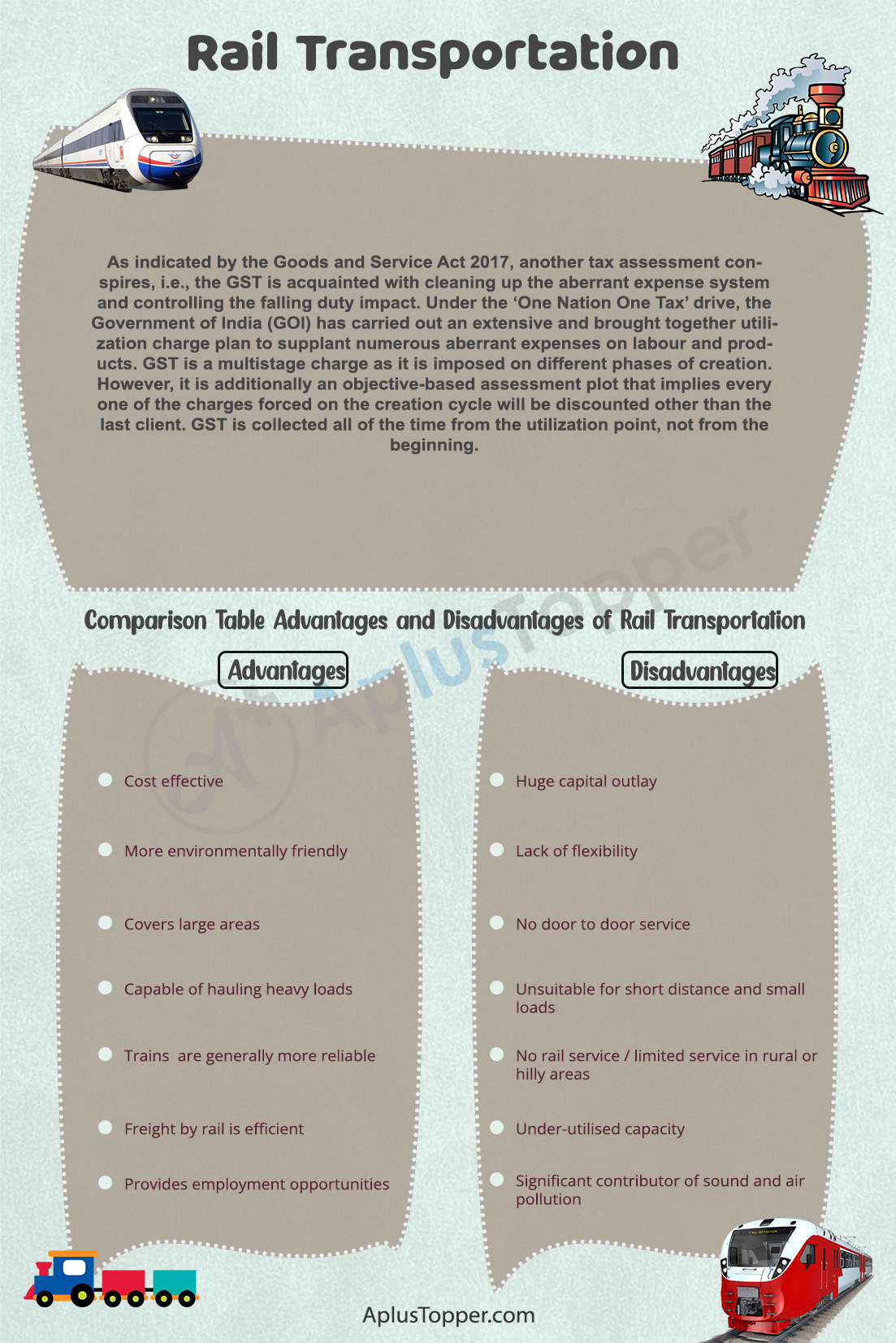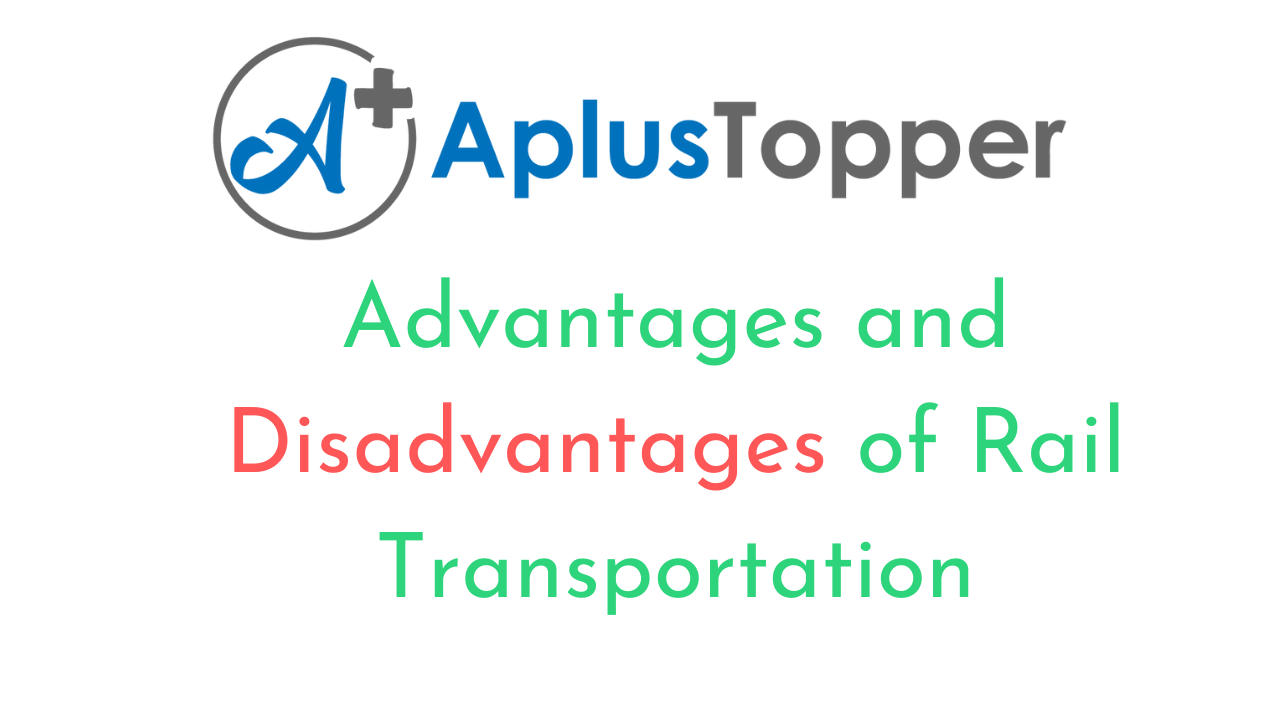Rail Transportation Advantages And Disadvantages: Rail transportation is one of the oldest modes of transportation in the world and has many advantages and disadvantages. Rail transportation is also a popular mode of transportation because it’s very effective at distributing goods and services. Unlike some other modes of transportation, rail transportation is cheaper and reasonably quick. This makes rail systems particularly useful for moving people or goods to different parts of a country.
Additionally, most modern rail transportation is environmentally friendly since it does not produce any greenhouse gases. Furthermore, rail transportation is more flexible than other modes of transport. In this article, you will find out about the various aspects of rail transportation that may be beneficial for your city, and how these different options can affect your day-to-day life.
Students can also find more Advantages and Disadvantages articles on events, persons, sports, technology, and many more.
What is Rail Transportation? Advantages and Disadvantages of Rail Transportation 2022
Rail transportation is a mode of transport used for the movement of goods and people. It is one of the most widely used modes of transportation worldwide, accounting for about 37% of global ton-kilometres (a unit of transportation measurement). In contrast to road transport, rail operations are generally considered more environmentally friendly due to their lower specific fuel consumption per passenger and per tonne-kilometre. It also has lower levels of pollution by weight than road transport.
- Advantages of Rail Transportation
- Disadvantages of Rail Transportation
- Comparison Table Advantages and Disadvantages of Rail Transportation
- Conclusion on Rail Transportation Advantages And Disadvantages
- FAQs on Rail Transportation Advantages And Disadvantages
Advantages of Rail Transportation
- Cost Effective – Rail transport is becoming more and more important as the cost of fuel goes up. The advantages of rail transport are that the train can take you to your destination quickly and fuel costs are much lower than other forms of transport. For example, it can be up to 80% cheaper than air transport and up to 50% cheaper than road transport. Rail transport also reduces CO2 emissions by as much as 50% compared to road transport.
- More environmentally friendly – Rail shipping can be more environmentally friendly than other methods of transport, such as shipping by truck or air. Rail cargo ships only use about 10% of the energy trucks do, and rail cars are less likely to emit carbon dioxide into the air. In addition, it takes approximately a third of the amount of time for a train to arrive at its destination when compared to road or water transport.
- Covers large areas – Rail transportation is the preferred way to transport goods and passengers across large geographical areas including over land and sea. Trains can often carry more cargo per hour than trucks or ships, making it a cost-effective solution for transporting both goods and people.
- Capable of hauling heavy loads – Trains are capable of carrying very large loads and potentially moving large numbers of people in more efficient ways. Generally, trains can haul up to 2,000 tons and have the ability to travel at more than 100 mph. In other words, rail transportation is a cost-effective way to carry heavy loads across long distances. They also experience a lower incidence of accidents, making them safer than other modes of transportation.
- Trains are generally more reliable – Trains are not only more comfortable and convenient than driving, they’re also safer. They are usually much more reliable than cars because they run on a track system which is less likely to be obstructed by traffic or other events that could cause delays. This is ideal for commuters who depend on their daily commute to work. Moreover, trains are also seen as environmentally friendly because they contribute to the reduction of carbon emissions caused by cars.
- Freight by rail is efficient – Rail freight is an efficient way to move goods because it’s not as expensive as trucking. Trains can also carry more goods at a much cheaper cost than trucks, which makes them a boon for most businesses. This is because there are fewer costs associated with operating and maintaining railroads.
- Provides employment opportunities – Rail transportation is a key component of our national infrastructure. The rail industry has been steadily growing, providing jobs and opportunities for people from all walks of life.
Disadvantages of Rail Transportation
Rail transportation is considered to be a solution to many of the problems caused by car traffic, yet there are many disadvantages to this option that include environmental impacts and higher costs. In addition, rail transportation is not suitable for all uses because it lacks flexibility. Other prominent disadvantages of rail transportation is as follows:
- Huge Capital Outlay – All large transportation projects require a huge initial investment. The amount of money needed for a rail project to be completed is often in the billions or even tens of billions of dollars. These costs only include the physical infrastructure such as tracks and trains, not including other things such as insurance, maintenance, and land acquisition. As a result, rail projects often have long lead times before they can actually be implemented.
- Lack of Flexibility – Some people may find rail transportation advantageous, but it is not an option for everyone. If you are living in a rural area with no access to rail transportation, going out to get groceries may be difficult. Large crowds can also be a problem during peak times of the day when trains are crowded with commuters – and this can be rather inadvisable, given the current global pandemic.
- Lack of Door to Door Service – The lack of door-to-door service is a disadvantage to rail transportation. This means that travellers must travel out of their way to get a bus or metro card in order to take advantage of the convenience and quickness of rail. It also means that you need to carry around your payment options in case something happens during transit.
- Unsuitable for Short Distance and Small Loads – Rail transportation is great for long-distance, high-load and high-value shipments. But not so much for small loads or short distances. It’s very expensive to transport these items via rail, and often much more expensive than alternatives such as road transport.
- No rail service / limited service in rural or hilly areas – Rail transportation is not as accessible as some other types of transportation, mainly because it is not as flexible and doesn’t go through many places, especially if the route has to pass through hilly and inaccessible terrain.
- Under-utilised Capacity – One of the biggest disadvantages of rail is under-utilised capacity. Rail transport is less flexible than other modes of transportation like road and air, which makes it difficult for railways to quickly adapt in times of demand shifts or emergencies. Though not the case in India, other countries like the US carry just 9% of all passenger and freight traffic in the country via rail.
- Significant contributor of sound and air pollution – Rail transportation is not environmentally friendly because it creates a high amount of pollution. For example, adding more tracks to already existing rail lines increases the amount of disturbance and the resulting sound waves. This type of transportation has a significant impact on the surrounding communities and plants nearby. However, some modern types of trains run on electricity – which are harnessed from reusable sources.

Comparison Table Advantages and Disadvantages of Rail Transportation
Following are the advantages and disadvantages of using rail transport:
| Advantages | Disadvantages |
| Cost effective | Huge capital outlay |
| More environmentally friendly | Lack of flexibility |
| Covers large areas | No door to door service |
| Capable of hauling heavy loads | Unsuitable for short distance and small loads |
| Trains are generally more reliable | No rail service / limited service in rural or hilly areas |
| Freight by rail is efficient | Under-utilised capacity |
| Provides employment opportunities | Significant contributor of sound and air pollution |

Conclusion on Rail Transportation Advantages And Disadvantages
Many people use rail transportation for goods and for commuting. Rail transportation is a cost-effective, efficient and environmentally friendly way of transporting cargo and passengers. Rail transportation offers advantages over its counterparts such as roadways. These advantages include fewer greenhouse gas emissions, safety, convenience to passenger and cargo, improved speed of transport and ease of use.
Moreover, the environmental impact of transportation has become a major issue and there are many reasons why trucks should not be used for transportation. First, rail shipping is more energy efficient. Trucking uses 10 times more fuel than trains to transport the same amount of goods. Rail can also reduce pollution because it’s zero-emission technology. Rail shipments in general are also safer and require less maintenance than those carried by trucking companies.
However, as with any form of transportation, there are some drawbacks that come along with it. For rail transportation, these include the cost of the train and its limited ability to reach remote and inaccessible places. Regardless, it is a versatile mode of transportation and has been around longer than other types of public transport.
FAQs on Rail Transportation Advantages And Disadvantages
Question 1.
What is rail transport? How do you define it?
Answer:
Rail transport is the use of rail systems for the transport of passengers and goods. It includes passenger trains, freight trains, rapid transit, trams and light rail. Rail transport systems are generally categorised as either freight or passenger railways.
Question 2.
What are the advantages of rail transport?
Answer:
Rail transport is a fast, efficient and environmentally friendly way to move goods or passengers. It is clean and has minimal emissions compared to other forms of transport.
Question 3.
What are the disadvantages of rail transport?
Answer:
There are many disadvantages of rail transport, especially for the environment. For instance, rail transport can disrupt local ecosystems by causing fragmentation and habitat loss, which leads to species extinction.
